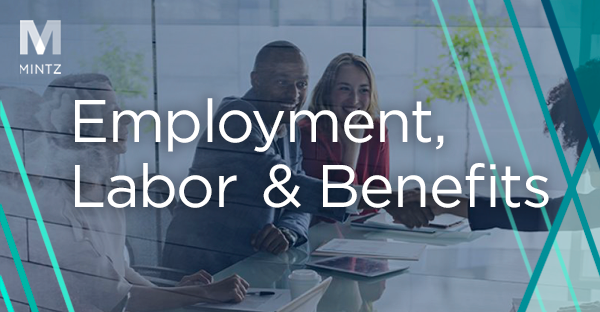
Employment
Viewpoints
Filter by:
The Impact of the CARES Act on Employee Welfare Benefit Plans, Programs, and Arrangements
April 14, 2020 | Blog | By Patricia Moran
The CARES Act is the third significant piece of federal legislation recently enacted in response to the COVID-19 pandemic. This post focuses on the provisions of the CARES Act that affect welfare benefit plans.
Read more
California’s Local Governments Expand Paid Sick Leave Laws
April 14, 2020 | Blog | By Paul Huston
The cities of Los Angeles, San Francisco, and San Jose have each adopted paid sick leave measures to assist workers not covered by the federal Families First Coronavirus Response Act during the COVID-19 crisis.
Read more
Not a COVID-19 Blog Post: New York State Passes Permanent Paid Sick Leave Measures into Law
April 8, 2020 | Blog | By Michael Arnold, Corbin Carter
Following the enactment of COVID-19 quarantine leave benefits in March, New York State has now enacted permanent paid sick leave measures, which will require New York employers to provide various amounts of sick leave to employees starting on January 1, 2021. This post highlight the new requirements of the law.
Read more
UPDATED: Leave Tracking and Recordkeeping Under Covid-19: Adjusting for the New Normal
April 8, 2020 | Blog | By Jennifer Rubin
One important question the Families First Coronavirus Response Act (“FFCRA”) and other recent legislative changes raise for employers is how to track and account for employee leaves. While most employers already have systems in place to track employee absences, employers should review their pre-pandemic recordkeeping to account for the “new normal” and new laws. These updates are not only to account for the FFCRA and any other federal or state laws – including the potential application for tax credits – but also, just as importantly, in anticipation of the return to work of the employer’s workforce.
Read more
COVID-19: Handling a Positive Diagnosis in the Workforce
April 8, 2020 | Blog
As the COVID-19 outbreak continues to disrupt normal workplace operations, an increasing number of employers are facing the reality of employees testing positive for the virus – particularly in industries like healthcare, construction, transportation, or retail, where workers cannot necessarily telecommute. Employees may also report to work sick, or become sick at work, and show COVID-19 symptoms. Even though employers may be hoping for the best, it is best to have a plan for the worst. Employers should have clear plans and procedures in place to address confirmed or presumptive COVID-19 cases in the workplace, which will enable employers to take swift, appropriate actions to minimize risk for their employees and operations. The following are guidelines for steps to take in addressing these situations:
Read more
Mandatory Arbitration in California
April 6, 2020 | Video | By Jennifer Rubin
Jen Rubin discusses that state of arbitration in California in light of the state law which took effect on January 1, 2020 banning mandatory arbitration and the ongoing lawsuit seeking to prevent the state from enforcing the new law.
Read more
What is AB 5?
April 6, 2020 | Video | By Jennifer Rubin
Jen Rubin reviews California’s AB 5 law which provides a new way to categorize independent contractors in the state. Jen explains that the law applies to all businesses and discusses the three categories of exemptions as well as the ABC test.
Read more
Political Speech in the Workplace
April 6, 2020 | Video | By Jennifer Rubin
Jen Rubin reviews legal considerations regarding regulating political speech in the private workplace.
Read more
Best Practices for AB 5 Compliance
April 6, 2020 | Video | By Jennifer Rubin
Jen Rubin explains that business should review existing contracts to ensure that they have properly classified individuals under California’s AB 5 law and provides guidelines for addressing any potential issues.
Read more
COVID-19 Considerations: Midyear Reductions or Suspensions of Employer & Matching Contributions to 401(k) and Defined Contribution Plans
April 3, 2020 | Blog
Beyond COVID-19’s devastating impact on public health is its second order effects on the U.S. and world economy. Businesses of all sizes need to trim costs. An obvious place to start is with contributions to 401(k) and other tax-qualified retirement plans. This post reviews the options for cost cutting available to employers under their defined contribution 401(k) and profit sharing plans.
Read more
Employer-Funded, Tax-Free Disaster Relief Payments Available to Employees
March 31, 2020 | Blog
A timely and robust response to the COVID-19 virus demands the attention and resources of, and action by, federal and state regulators, employers, and individuals alike. The stakes could not be higher. State and local “shelter-in-place” orders have effectively, if not actually, resulted in widespread job losses for at least some indeterminate period of time.
Read more
Summary of CARES Act for Employers
March 27, 2020 | Blog | By David Lagasse, Danielle Bereznay
Congress has now passed the CORONAVIRUS AID, RELIEF AND ECONOMIC SECURITY ACT OR CARES ACT – Federal government’s Phase III response to the health and economic impacts related to the COVID-19 pandemic. President Trump has pledged to sign the Act into law immediately.
Read more
New York State to Provide Paid Sick Leave, Other COVID-19 Protections for Workers
March 27, 2020 | Blog | By Michael Arnold, Corbin Carter
As New York State announced that it had confirmed over 2,300 cases of the COVID-19 coronavirus, New York Governor Andrew Cuomo signed into law new requirements for New York State employees affected by the virus. The new law was swiftly enacted in light of the urgent public health and economic crises facing the state, and goes into effect immediately. It mandates that New York employers offer paid sick leave and job protections for workers quarantined as a result of the coronavirus outbreak.
Read more
Governor of Massachusetts Orders Closure of All Non-Essential Businesses Due to Spread of COVID-19; Effective Tuesday, March 24th at 12 P.M. until April 7th at 12 P.M.
March 23, 2020 | Blog | By Delaney Busch
This morning, Massachusetts Governor Baker issued Covid Order No. 13 which mandates that, starting Tuesday, March 24th at 12 P.M., all non-essential businesses and other organizations “shall close their physical workplaces and facilities (“brick-and-mortar premises”) to workers, customers, and the public,” due to evolving spread of COVID-19 in Massachusetts. This directive also orders that, in furtherance of Massachusetts’s COVID-19 response efforts, all non-essential businesses and organizations “are encouraged to continue operations where they are able to operate through remote means that do not require worker, customers, or the public to enter or appear at the brick-and-mortar premises closed by this Order.”
Read more
Mobilizing Against COVID-19: Emergency Responder and Military Leave
March 22, 2020 | Blog | By Michael Arnold
As the United States continues to develop its response to the COVID-19 pandemic, thousands of members of the National Guard will be activated to help deal with the threat. Last week, Massachusetts Governor Charlie Baker activated 2,000 of the state’s National Guardspeople to aid the COVID-19 fight. As states assess how to use the National Guard to assist with the current state of emergency, service members will be called on to serve in increasing numbers.
Read more
OFCCP Announces Relief From AAP Requirements For COVID-19 Related Federal Contracts
March 22, 2020 | Blog
The Office of Federal Contract Compliance Programs (OFCCP) announced that for the three month period from March 17, 2020 to June 17, 2020, it will provide a temporary exemption to certain federal contracting requirements. The exemption is related to work under federal construction and service/supply contracts to provide COVID-19 relief.
Read more
Governor Newsom Implements “Shelter in Place” Order in California – What this Means for Your Business
March 21, 2020 | Blog | By Paul Huston
Late Thursday evening California Governor Gavin Newsom issued Executive Order N-33-20 (the “Order”), which directs all California residents to stay home in light of the developing COVID-19 public health crisis. The Order states that except as necessary to continue the operations of businesses in the 16 “Critical Infrastructure” industries, all residents should leave their residence only as necessary for food or medical needs.
Read more
In the COVID-19 Economy, Employers Should Be Prepared for Increased 401(k) Hardship Distributions
March 20, 2020 | Blog | By Patricia Moran
401(k) plans must, by law, limit the circumstances under which plan money can be withdrawn by active employees. However, 401(k) plans can (and most do) allow in-service withdrawals in the event of an employee’s financial hardship. The COVID-19 pandemic is guaranteed to have financial repercussions for many 401(k) participants, and hardship distributions may provide a financial bridge to better times. The post summarizes the hardship distribution rules to help 401(k) plan sponsors prepare for an uptick in requests. It should be noted that the hardship distribution rules changed in 2018 and 2019, so employers are advised to confirm that they are familiar with the most current rules.
Read more
New York State Implements Strict In-Person Workforce Reduction Measures in Response to COVID-19, Effective Friday, March 20th
March 19, 2020 | Blog | By Michael Arnold, Corbin Carter
New York Governor Andrew Cuomo has issued an expansive executive order, which mandates that, beginning Friday, March 20, 2020, at 8:00 PM, all “non-essential” businesses and non-profits entities in New York State must reduce their in-office workforce by at least 75%, and where possible, utilize telecommuting arrangements.
Read more
Explore Other Viewpoints:
- Data Centers & Digital Infrastructure
- AI: The Washington Report
- Antitrust
- Appellate
- Arbitration, Mediation & Alternate Dispute Resolution
- Artificial Intelligence
- Awards
- Bankruptcy & Restructuring
- California Land Use
- Cannabis
- Class Action
- Complex Commercial Litigation
- Construction
- Consumer Product Safety
- Corporate Governance (ESG)
- Cross-Border Asset Recovery
- DEI Legal Developments
- Debt Financing
- Direct Investing (M&A)
- Diversity
- EB-5 Financing
- Education & Nonprofits
- Employment
- EnforceMintz
- Environmental (ESG)
- Environmental Enforcement Defense
- Environmental Law
- Environmental, Social, and Corporate Governance (ESG)
- FDA Regulatory
- False Claims Act
- Federal Circuit Appeals
- Financial Institution Litigation
- Government Law
- Growth Equity
- Health Care
- Health Care Compliance, Fraud and Abuse, & Regulatory Counseling
- Health Care Enforcement & Investigations
- Health Care Transactions
- Health Information Privacy & Security
- IP Due Diligence
- IPRs & Other Post Grant Proceedings
- Immigration
- Impacts of a New US Administration
- Insolvency & Creditor Rights Litigation
- Institutional Investor Class Action Recovery
- Insurance & Financial Services
- Insurance Consulting & Risk Management
- Insurance and Reinsurance Problem-Solving & Dispute Resolution
- Intellectual Property
- Investment Funds
- Israel
- Licensing & Technology Transactions
- Life Sciences
- Litigation & Investigations
- M&A Litigation
- ML Strategies
- Medicare, Medicaid and Commercial Coverage & Reimbursement
- Mergers & Acquisitions
- Patent Litigation
- Patent Prosecution & Strategic Counseling
- Pharmacy Benefits and PBM Contracting
- Portfolio Companies
- Privacy & Cybersecurity
- Private Client
- Private Equity
- Pro Bono
- Probate & Fiduciary Litigation
- Products Liability & Complex Tort
- Projects & Infrastructure
- Public Finance
- Real Estate Litigation
- Real Estate Transactions
- Real Estate, Construction & Infrastructure
- Retail & Consumer Products
- Securities & Capital Markets
- Securities Litigation
- Social (ESG)
- Special Purpose Acquisition Company (SPACs)
- Sports & Entertainment
- State Attorneys General
- Strategic IP Monetization & Licensing
- Sustainable Energy & Infrastructure
- Tax
- Technology
- Technology, Communications & Media
- Technology, Communications & Media Litigation
- Trade Secrets
- Trademark & Copyright
- Trademark Litigation
- Unified Patent Court (UPC)
- Value-Based Care
- Venture Capital & Emerging Companies
- White Collar Defense & Government Investigations
- Women's Health and Technology




